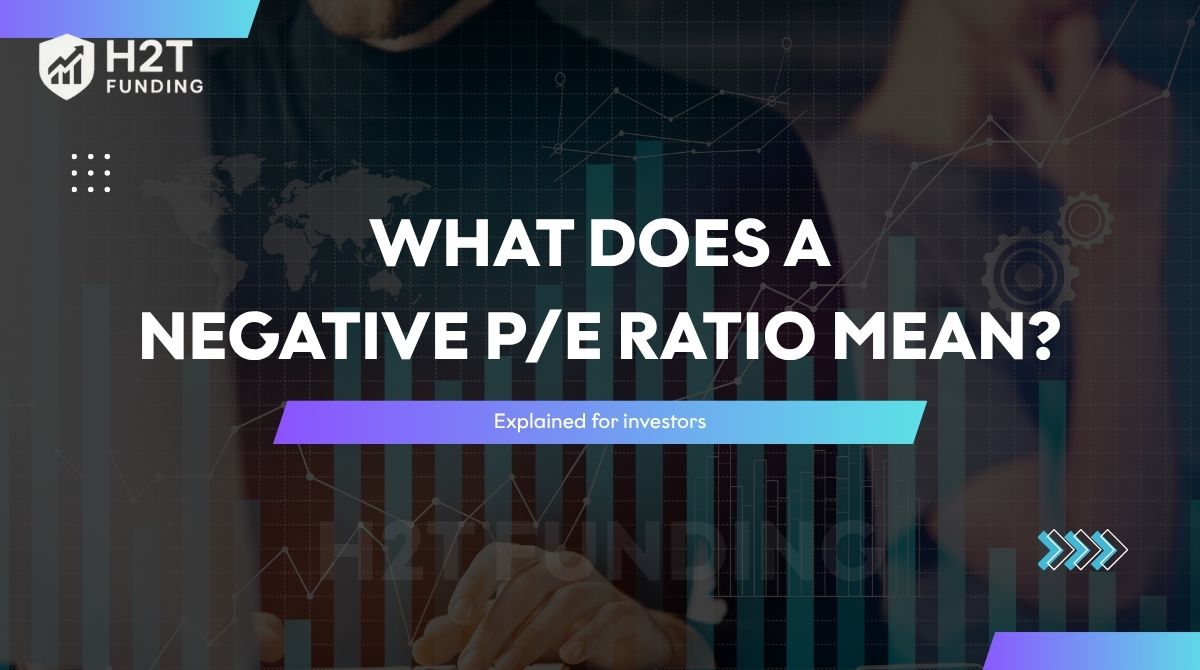For new stock market investors, a negative P/E ratio may be perplexing initially. It is experienced when the earnings per share (EPS) are lower than zero, a sure indication of being loss-making and the risk involved in investment choices.
This frequently brings the investor to a very important question: What does a negative P/E ratio mean, and how will it affect their investment policy? A positive P/E is a very easy valuation tool, but a negative number sends a wholly opposite signal that will need to change your investment policy.
H2T Funding discusses why the P/E ratio may become negative, how it’s valued in the current market conditions, and when these companies are still good for a balanced investment portfolio.
Key takeaways:
- A Negative P/E Ratio occurs when EPS is a negative number, indicating the firm is running losses.
- It indicates loss, not profit, but doesn’t necessarily guarantee that the business will collapse.
- Startups, growth companies, or companies devastated by crises also have adverse P/E ratios.
- Investors need to look beyond P/E: consider sales growth, operating liquidity, leverage, and industry prospects.
- A negative P/E is a red flag for short traders but a long-term buying opportunity if things improve fundamentally.
1. What is the P/E ratio?
The price-to-earnings (P/E) ratio is a widely used valuation metric in the stock market. It shows how much investors are willing to pay for each unit of a company’s profit. In simple terms, the P/E ratio connects a company’s share price with its earnings per share (EPS), offering a snapshot of its relative value.
Formula: P/E = Price per Share / Earnings per Share (EPS)
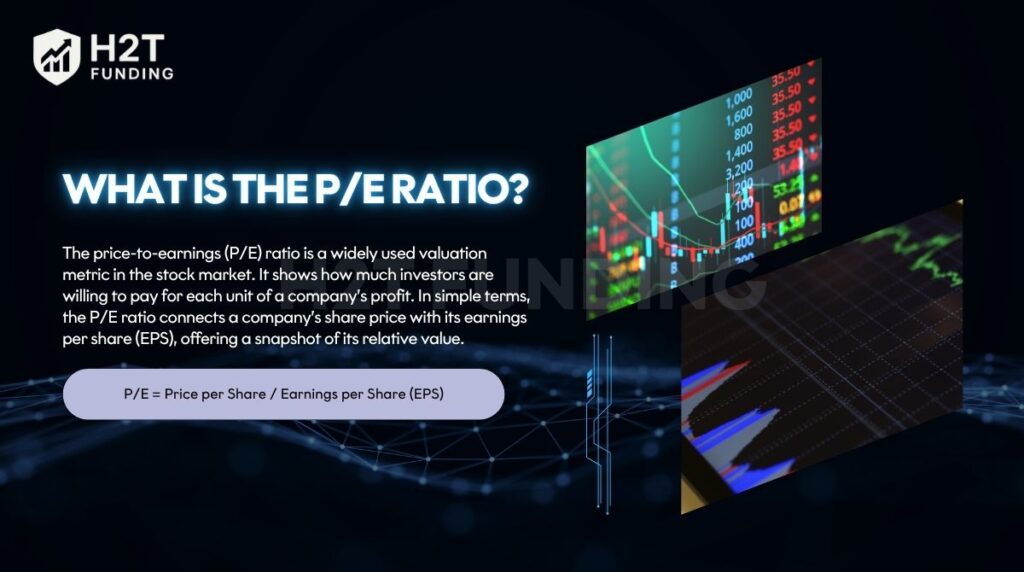
Investors rely on this ratio because it makes stock valuation more intuitive. Instead of just looking at raw numbers like revenue or net income, the P/E helps compare companies across industries or against the broader equity market.
For example, a firm trading at a P/E of 15 means investors are paying $15 for every $1 of earnings.
The ratio also adjusts with market conditions and the firm’s accounting methods, since write-downs or revenue recognition choices can shift reported earnings. This is why financial analysts, portfolio managers, and even everyday traders use it as a cornerstone in their investment decisions.
2. What does a negative P/E ratio mean?
A negative P/E ratio occurs when a company’s earnings per share (EPS) are below zero. Put simply, the firm is unprofitable, and instead of generating net income, it is recording net losses.
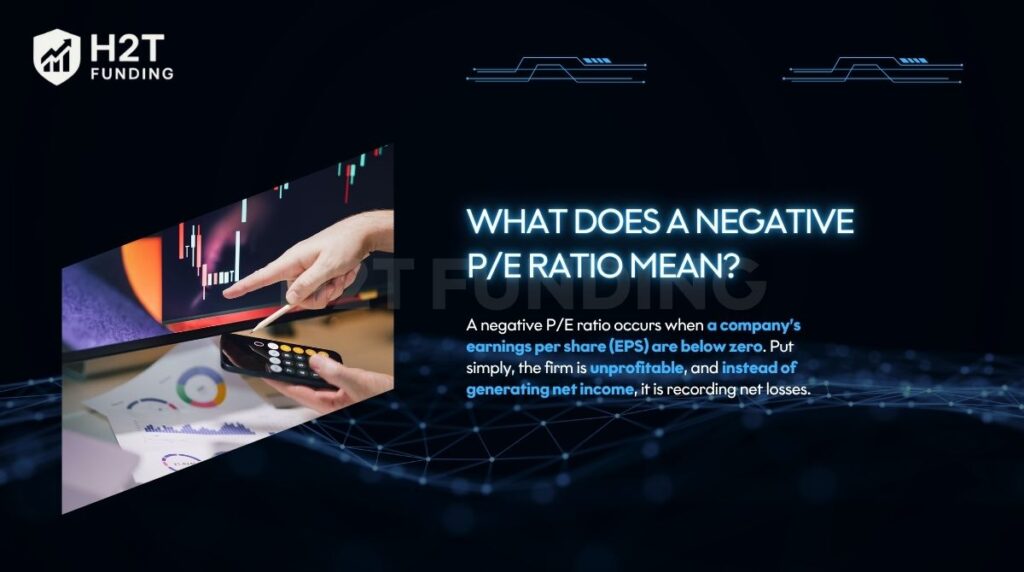
So, for an investor, what does a negative P/E ratio mean in practical terms? At its core, it signals that the company’s EPS is below zero, meaning it’s currently unprofitable and possibly facing short-term pressure in its financial performance.
Unlike a positive P/E, which tells you the price you’re paying for $1 of profit, a negative P/E ratio tells you there are no profits to measure. This renders the metric useless for direct valuation comparisons and forces you to dig deeper.
In practice, what happens if the P/E ratio is negative is that analysts cannot use it directly to compare value across profitable companies. Investors shouldn’t rely only on a negative P/E ratio but also review cash flow and revenue growth. In addition, evaluating the margin of safety is an essential factor for sound investment decisions; learn more in our guide on the margin of safety formula percentage.
Comparison: Positive vs. Negative P/E Ratio
| Aspect | Positive P/E Ratio | Negative P/E Ratio |
|---|---|---|
| EPS | Greater than 0 (company is profitable) | Less than 0 (company is unprofitable) |
| Meaning | Shows how much investors pay for each dollar of earnings | Indicates losses; no earnings to measure |
| Usefulness | Helps compare valuation across companies/industries | Limited; requires looking at other financial metrics |
| Investor interpretation | High P/E = growth expectations, Low P/E = possible undervaluation | Signals caution; may reflect early growth phase or financial trouble |
3. Why can a P/E ratio be negative?
A P/E ratio turns negative when a company is not generating profits. This typically means the company’s net losses exceed its revenues, but the reasons can vary depending on its structure and market conditions. Understanding these causes is essential for sound investment decisions.
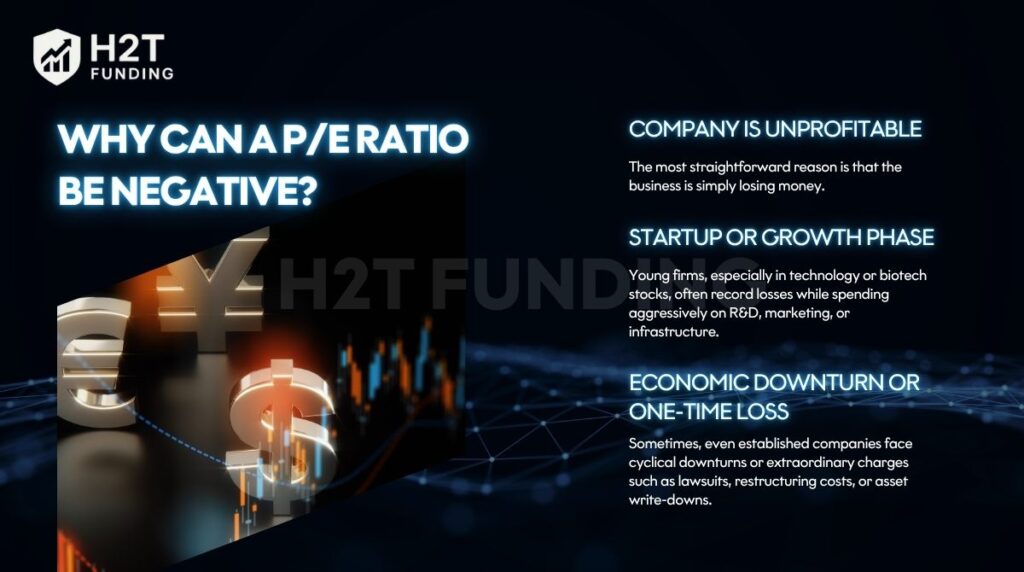
3.1. Company is unprofitable (net losses)
The most straightforward reason is that the business is simply losing money. Unprofitable companies, whether due to declining demand, poor cost management, or heavy debt, report negative EPS. When this happens, the P/E ratio also becomes negative, signaling that traditional stock valuation methods are less reliable.
Unprofitable companies should also reassess their leverage strategy, as excessive borrowing can worsen a negative P/E ratio. Learn more in our guide on what is leverage in trading.
3.2. Startup or growth phase (heavy investment, no profit yet)
Young firms, especially in technology or biotech stocks, often record losses while spending aggressively on R&D, marketing, or infrastructure. During this growth phase, their EPS is negative even though revenue may be rising.
This explains why many promising startups or growth companies show a negative P/E ratio in their early years, a typical case of short-term unprofitability for long-term investment potential. Tesla and Amazon both had extended periods of negative P/E before turning profitable.
The difference between saving and investing also affects how startups manage cash flow and profit expectations. Explore this further in our article on saving vs investing: pros and cons.
3.3. Economic downturn or one-time loss
Sometimes, even established companies face cyclical downturns or extraordinary charges such as lawsuits, restructuring costs, or asset write-downs. These one-off expenses can push earnings into negative territory for a quarter or even longer.
For example, major airlines posted negative P/E ratios during the COVID-19 pandemic despite having profitable business models before.
Negative P/E ratios, therefore, don’t always point to long-term failure. They may reflect short-term conditions, investment for future growth, or temporary shocks in market conditions.
During volatile market conditions, understanding drawdown and risk management becomes crucial for investors. Learn more in our article what is drawdown in trading.
4. How to interpret a negative P/E in investing?
With a negative P/E ratio taught in the context of investment, the important point is that it is impossible to utilize it like a regular P/E, but rather needs further analysis of EPS trends and market conditions prior to making investment conclusions.
Rather than giving a shortcut to valuation, it asks the investor to look further than overall financial wellness and determine if losses are temporary or strategic or are evidence of further trouble.
4.1. Negative P/E ≠ automatically bad
Negative P/E ratio, meaning see-through, does not necessarily invalidate a stock’s attractiveness; it simply indicates a short-term unprofitable period that needs long-run investment vision. Most companies show losses when they expand or innovate. A negative number in such instances indicates short-run suffering for long-run profit.
Some such companies were Amazon, Tesla, and most biotech companies that sported negative P/E values prior to yielding handsome returns. For a rounded investment policy, review our article on 3-fund portfolio allocation by age that guides risk and return management in the long run.
4.2. Consider revenue growth, cash flow, and industry average
To understand what a negative price-to-earnings ratio indicates, look beyond the headline number.
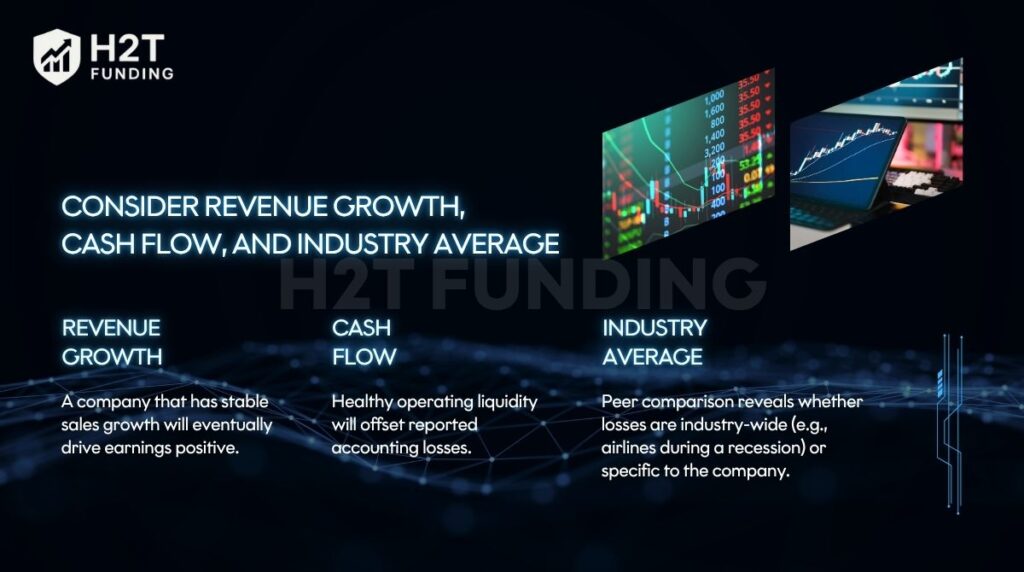
- Revenue growth: A company that has stable sales growth will eventually drive earnings positive.
- Cash flow: Healthy operating liquidity will offset reported accounting losses.
- Industry average: Peer comparison reveals whether losses are industry-wide (e.g., airlines during a recession) or specific to the company.
These factors segregate transitory losses from underlying weakness. Measuring investment performance, the Sharpe ratio also attempts to measure return in comparison to risk. Learn more in our guide here about what is a good sharpe ratio.
4.3. Long-run investors can take a look
For long-term holders, a declining P/E ratio may still suit an investment idea of future growth and innovation if the fundamentals of the company and EPS recovery trajectory are sound.
If the fundamentals, such as innovation, market share, and scalability, are sound, the stock could be undervalued irrespective of losses incurred. In such a scenario, talking to your financial advisors and running a thorough risk analysis is advisable before concluding.
4.4. Short traders need to be careful
For day traders, an adverse P/E generally indicates greater volatility and less predictability. Loss-making corporations may experience steep sell-downs when the result is poor. For that reason, a defensive attitude towards rigid investment decisions, definite stop-loss levels, and vigilant observation of the economic climate is required.
A negative P/E ratio is something that needs to be understood in the context. It may indicate losses for the time being, initial stage growth, or structural fall. It may indicate a latent opportunity for long-term investors, but a red flag requiring additional caution for short-term traders. For making better short-term trading decisions, have a look at our comparison of simple vs exponential moving averages.
5. Negative P/E ratio vs low P/E ratio
A negative P/E ratio is very different from a low P/E. While both can seem like signals of “cheap” stocks, the underlying story is not the same. A low P/E shows the company is profitable but valued conservatively, while a negative P/E signals the firm is losing money. Understanding this distinction helps avoid misreading the valuation metric.
Quick comparison table:
| Aspect | Low P/E Ratio | Negative P/E Ratio |
|---|---|---|
| EPS | Positive (company makes a profit) | Negative (company reports losses) |
| Interpretation | The stock may be undervalued, or growth expectations may be low | The company is unprofitable; no earnings to value |
| Investor view | Can be attractive if fundamentals are stable | Requires a deeper analysis of the company’s performance and outlook |
| Risk level | Moderate – depends on growth prospects | High losses may persist or worsen |
| Common cases | Mature firms, cyclical sectors, value stocks | Startups, biotech firms, companies in downturns |
A low P/E ratio often suggests a stock could be undervalued compared to peers, while a negative P/E ratio highlights unprofitability and signals caution in investment decisions.
Investors should not confuse the two; one reflects cautious market pricing, the other reflects ongoing financial losses. To better identify key price levels in stock trading, explore our article what is support and resistance.
6. Real-world examples of negative P/E stocks
A negative P/E ratio is not rare in financial markets. Some of the world’s most recognizable companies have experienced it at different stages. These cases show that the meaning of negative P/E depends on timing, company performance, and market context.
Tesla before 2020:
For years, Tesla reported net losses due to massive spending on factories, battery technology, and global expansion. Its stock performance was volatile, and many analysts doubted its ability to achieve profitability. During this period, Tesla carried a negative P/E ratio, yet long-term investors who believed in its growth vision eventually benefited once the company turned profitable in 2020.
Biotech startups with heavy R&D:
Biotech stocks are classic examples of negative P/E. They often spend years investing in research and clinical trials before earning any revenue. As a result, EPS remains negative for long periods. While their valuation may look unattractive using P/E, investors track margin trends, innovation pipelines, and funding capacity instead of profits.
Airlines during the COVID-19 crisis:
In 2020, airlines worldwide faced a collapse in demand, grounded fleets, and billions in one-off expenses. Many posted severe losses, resulting in negative P/E ratios. For some, this highlighted temporary stress tied to the pandemic; for others with high debt, it raised serious bankruptcy risk. This case showed how external shocks can distort traditional metrics.
Conclusion: Real-world examples prove that negative P/E ratios appear across different sectors from high-growth innovators like Tesla to cyclical industries like airlines. Investors must always analyze the context, as losses can signal either temporary challenges or deeper structural issues. If you’re exploring automated or systematic strategies, learn more in our guide Mastering Grid Trading.
7. Should you invest in companies with negative P/E?
The question “what if the P/E ratio is negative” ultimately depends on an investor’s risk tolerance, market conditions, and long-term investment horizon. While some negative P/E stocks later become market leaders, others remain unprofitable and destroy shareholder value.
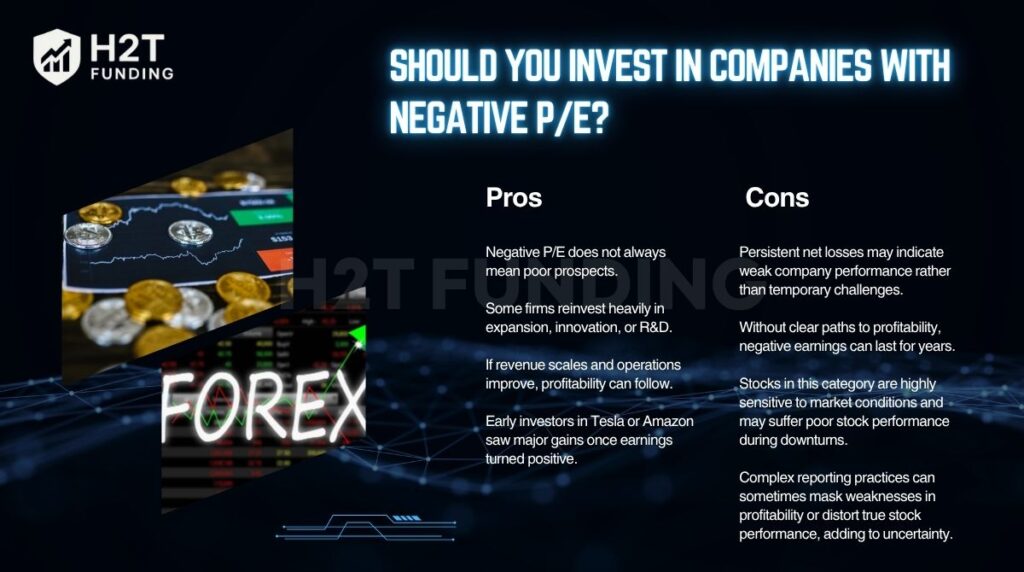
Pros: Potential for strong growth:
- Negative P/E does not always mean poor prospects.
- Some firms reinvest heavily in expansion, innovation, or R&D.
- If revenue scales and operations improve, profitability can follow.
- Early investors in Tesla or Amazon saw major gains once earnings turned positive.
Cons: Prolonged risk of losses:
- Persistent net losses may indicate weak company performance rather than temporary challenges.
- Without clear paths to profitability, negative earnings can last for years.
- Stocks in this category are highly sensitive to market conditions and may suffer poor stock performance during downturns.
- Complex reporting practices can sometimes mask weaknesses in profitability or distort true stock performance, adding to uncertainty.
Practical guidance for investors: If you consider investing in a company with a negative P/E, go beyond the ratio:
- Review ROE (Return on Equity) to gauge efficiency.
- Study cash flow statements for real liquidity, not just accounting profits.
- Check the Debt Ratio to ensure leverage is sustainable.
- Compare results with industry peers to identify whether losses are cyclical or structural.
Investing in negative P/E stocks is not inherently wrong, but it carries higher risk. The key is careful investment analysis, focusing on financial health, competitive advantage, and long-term potential. For cautious investors, such companies may not be suitable; for those seeking growth opportunities, they can be attractive if fundamentals are strong.
8. FAQs
Yes. A negative P/E is usually temporary. If the firm improves operations and returns to profitability, EPS turns positive, and the ratio normalizes.
It depends on the industry and business model. Some startups stay negative for years due to high R&D spending, while cyclical firms may turn positive after a downturn.
A low P/E often signals undervaluation with profits intact, while a negative P/E reflects losses. For most investors, a low P/E is safer than a negative P/E.
Yes. If a profitable company suddenly reports losses, its P/E turns negative even if it continues paying dividends from reserves or past earnings.
Not inherently ‘bad,’ but it is a sign of unprofitability that requires careful investigation. Essentially, what a negative P/E means is that a company is losing money. The critical question is why. For a startup investing heavily in future growth, it could be a temporary and necessary phase. For a declining business, it could be a warning of failure.
Buffett views the P/E ratio as useful but incomplete. He stresses looking at cash flow, ROE, and business quality rather than relying on a single metric.
It can be, if the company’s fundamentals are strong. But sometimes a low P/E reflects weak growth expectations or structural problems.
A P/E ratio of 0 usually indicates that earnings per share are exactly zero. It signals break-even performance, no profit, no loss.
The P/E ratio is a valuation metric comparing the share price to earnings per share. It shows how much investors pay for each unit of profit.
Examples include Tesla before 2020, biotech stocks in heavy R&D phases, and airlines during the COVID-19 crisis. These illustrate what a negative price-to-earnings ratio means in practice.
A negative P/E ratio happens when EPS is below zero. In other words, the firm is unprofitable, and the ratio reflects losses instead of earnings.
9. Conclusion
What does a negative P/E ratio mean? It means EPS is below zero, showing that the company is unprofitable at present. This doesn’t automatically indicate failure; instead, investors should analyze market conditions, liquidity, and long-term fundamentals before making any investment decisions.
Focus on why earnings are negative and whether losses look temporary or structural. Review operating liquidity, ROE, leverage, and peer benchmarks before making any decision. Short-term traders should stay cautious; long-term investors may act only when the business case is strong.
Want practical next steps? Explore H2T Funding’s guides on valuation, and dive into our Prop Firm & Trading Strategies category to sharpen risk control and execution for your portfolio.

